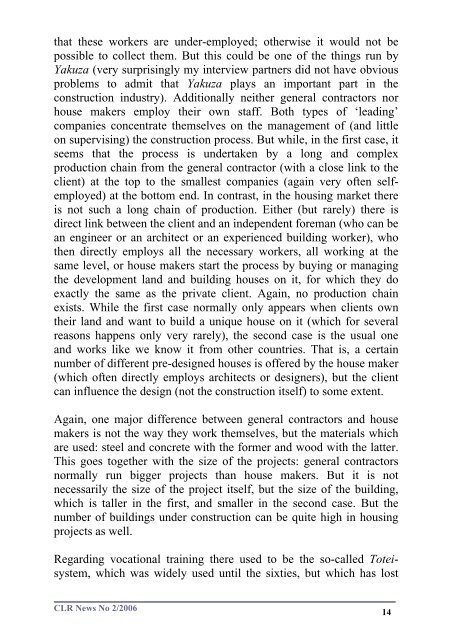Japan – what can we learn? - Construction Labour Research
Japan – what can we learn? - Construction Labour Research
Japan – what can we learn? - Construction Labour Research
You also want an ePaper? Increase the reach of your titles
YUMPU automatically turns print PDFs into web optimized ePapers that Google loves.
that these workers are under-employed; otherwise it would not bepossible to collect them. But this could be one of the things run byYakuza (very surprisingly my interview partners did not have obviousproblems to admit that Yakuza plays an important part in theconstruction industry). Additionally neither general contractors norhouse makers employ their own staff. Both types of ‘leading’companies concentrate themselves on the management of (and littleon supervising) the construction process. But while, in the first case, itseems that the process is undertaken by a long and complexproduction chain from the general contractor (with a close link to theclient) at the top to the smallest companies (again very often selfemployed)at the bottom end. In contrast, in the housing market thereis not such a long chain of production. Either (but rarely) there isdirect link bet<strong>we</strong>en the client and an independent foreman (who <strong>can</strong> bean engineer or an architect or an experienced building worker), whothen directly employs all the necessary workers, all working at thesame level, or house makers start the process by buying or managingthe development land and building houses on it, for which they doexactly the same as the private client. Again, no production chainexists. While the first case normally only appears when clients owntheir land and want to build a unique house on it (which for severalreasons happens only very rarely), the second case is the usual oneand works like <strong>we</strong> know it from other countries. That is, a certainnumber of different pre-designed houses is offered by the house maker(which often directly employs architects or designers), but the client<strong>can</strong> influence the design (not the construction itself) to some extent.Again, one major difference bet<strong>we</strong>en general contractors and housemakers is not the way they work themselves, but the materials whichare used: steel and concrete with the former and wood with the latter.This goes together with the size of the projects: general contractorsnormally run bigger projects than house makers. But it is notnecessarily the size of the project itself, but the size of the building,which is taller in the first, and smaller in the second case. But thenumber of buildings under construction <strong>can</strong> be quite high in housingprojects as <strong>we</strong>ll.Regarding vocational training there used to be the so-called Toteisystem,which was widely used until the sixties, but which has lostCLR News No 2/200614









